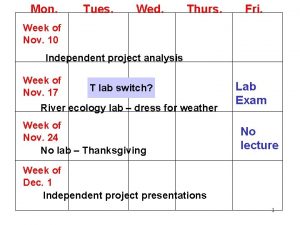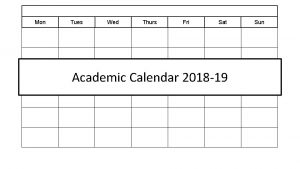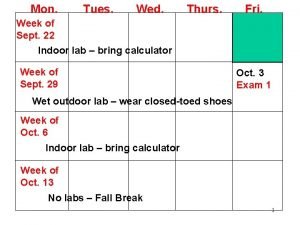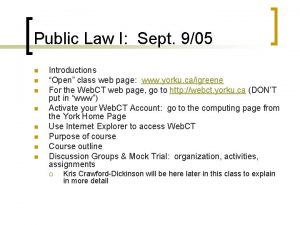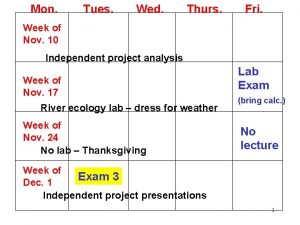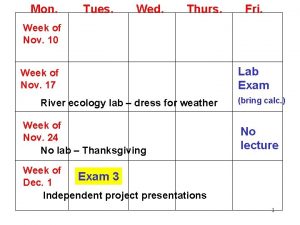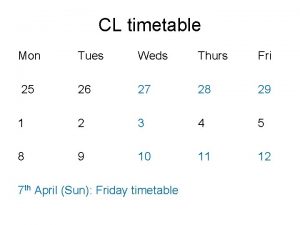Mon Tues Wed Thurs Fri Week of Sept




































- Slides: 36

Mon. Tues. Wed. Thurs. Fri. Week of Sept. 22 Indoor lab – bring calculator Week of Sept. 29 Oct. 3 Exam 1 Wet outdoor lab – wear closed-toed shoes Week of Oct. 7 Indoor lab – bring calculator Week of Oct. 14 No labs – Fall Break 1

Outline The biome concept Survey of the biomes Variability in Connecticut 2

Microclimate – climatic variation on a scale of a few kilometers, or centimeters 3

4

Coniferous forest Deciduous forest Wetlands, Water Residential, commercial Lawn and turf 5

Structure of course Environmental variability Organisms Ecosystems Populations Species interactions Communities Applied Ecological Issues 6

Outline for organisms Introduction What do organisms need to survive and reproduce? How do organisms cope with variability? 7

Organism – fundamental unit of ecology; an individual living being bounded by a covering which separates it from its environment Organismal approach – focus on how the organism interacts with its environment to survive and reproduce 8

Questions organismal ecologists ask How does an individual’s form, physiology, and behavior help it to survive in its environment? Why is the distribution of an organism limited to certain environments? Why do related organisms in different environments have different characteristics? 9

What do organisms need in order to survive and reproduce? energy water nutrients 10

Why do organisms need energy? ? 11

Fig. 2. 8 All organisms use energy given off in oxidation reactions Difference is where they get the reduced compounds 12

Organisms have two different methods to gain energy autotrophs - organisms that gain energy from either sunlight (photosynthesis) or inorganic compounds (chemosynthesis) heterotrophs - organisms that use organic materials (other organisms) as a source of energy 13

Types of heterotrophs - herbivores - eat autotrophs - carnivores - eat other heterotrophs - detritivores - eat dead organic matter - omnivores - eat more than one of the above 14

Why do organisms need water? 15

Fig. 2. 8 16

Fig. 2. 9 17

Why do organisms need nutrients? 18

Fig. 2. 22 19

Consumption = Metabolism + Egestion + Excretion + Growth + Reproduction INPUTS = STORAGE + OUTPUTS 20

Sooty tern - nest on bare sand in very hot climate - eat squid and fish from local area - nests are tended all of the time Shearwater - nest on bare sand or in burrows - eat squid and fish from far away - surface nests are often abandoned because parents get too hot 21

Fig. 2. 24 22

Niche: ecological role of a species in the community - determines the range of conditions an organism can tolerate, how it feeds, how it escapes enemies, etc. - no two species have the same niche 23

Habitat: the physical setting in which an organism lives 24

Outline for organisms Introduction and review of adaptation What do organisms need to survive and reproduce? How do organisms cope with variability? 25

How do organisms cope with variability? physiological adaptations behavioral adaptations developmental adaptations 26

Why do organisms have to cope with variability? i. e. , why does variability matter? 27

Fig. 9. 4 28

behavioral - organisms can alter their behavior to stay within range of environmental conditions required to survive and reproduce 29

30

31

physiological - the physiology of an organism can change such that the range of environmental conditions it can tolerate changes - reversible - acclimation 32

Figure 9. 9 33

Figure 9. 10 blue = grown at 20 C orange = grown at 40 C 34

developmental - particular traits of an organism may be affected by the environmental conditions under which it develops - irreversible 35

36
 Mon. tue. wed
Mon. tue. wed Mon tues wed
Mon tues wed Mon tues wed thurs fri
Mon tues wed thurs fri Thu wed
Thu wed Fri sat sun
Fri sat sun Mon tue wed thur fri
Mon tue wed thur fri Mon tues wed thurs fri sat sun
Mon tues wed thurs fri sat sun Wed thur fri
Wed thur fri Montue
Montue Sun mon tue wed thur fri sat
Sun mon tue wed thur fri sat Mon tue wed thu fri sat sun
Mon tue wed thu fri sat sun Mon to thurs
Mon to thurs Mon tue wed thurs fri sat sun
Mon tue wed thurs fri sat sun Mon tues wed thurs fri sat sun
Mon tues wed thurs fri sat sun Mon tues wed thurs fri
Mon tues wed thurs fri Mon tues wed thurs fri
Mon tues wed thurs fri Sat sun mon tues wed
Sat sun mon tues wed Wed thurs fri
Wed thurs fri Mon tue wed
Mon tue wed Sun-thu
Sun-thu Sun mon
Sun mon Xx calendar
Xx calendar Wed thr
Wed thr Mon tues
Mon tues Week by week plans for documenting children's development
Week by week plans for documenting children's development Sept heure moins le quart
Sept heure moins le quart I sept
I sept Candide ou l optimisme
Candide ou l optimisme Ecrivez les sept jours de la semaine
Ecrivez les sept jours de la semaine Damon poole
Damon poole Sept comme setteur questionnaire
Sept comme setteur questionnaire How many hills in jerusalem
How many hills in jerusalem Sept commandements
Sept commandements What does the prefix sept mean
What does the prefix sept mean Un deux trois quatre cinq six sept huit
Un deux trois quatre cinq six sept huit Cnn 10 august 31
Cnn 10 august 31 Le blaireau sans gêne poésie
Le blaireau sans gêne poésie


